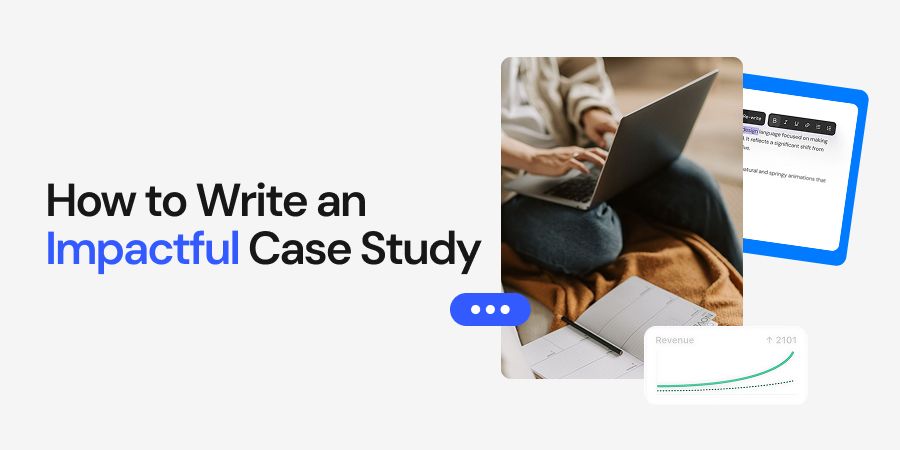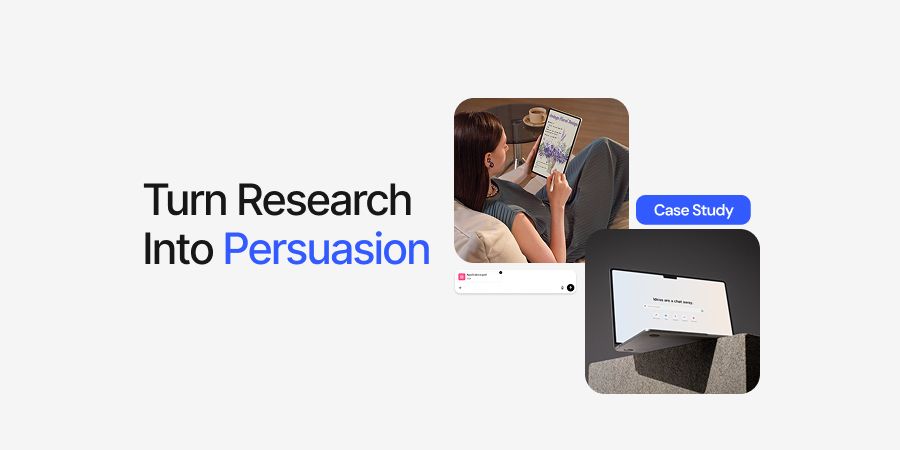
How to Write an Impactful Case Study
Have you ever read a case study that felt flat, as if someone was simply recounting a dull sequence of events? Yes, me too. We all have been there.
Case studies are unique and powerful pieces of content that have great powers, but only if it is a great mix of solid numbers and storytelling so it all makes sense. Because numbers convince, but stories persuade.
A case study does both at once, showing proof in a way that feels human and credible. Companies use them to prove value, students write them to analyze problems, and readers trust them because they bridge facts with lived examples.
A well-written case study highlights not just what was done but why it mattered. It captures a challenge, explains the solution, and proves results with evidence that cannot be argued away.
Done poorly, it becomes another bland document buried on a website. Done well, it becomes persuasive content that drives decisions, attracts customers, or earns top marks in a classroom.
This guide explains the structure of a case study, the steps to write one, and the qualities that make it impactful. By the end, you will know how to present problems, solutions, and results in a way that leaves an impression.
What is a Case Study?
A case study is a detailed account of a real situation, project, or client story. It shows how a challenge appeared, what action was taken, and what results followed. Unlike generic content, it does not speculate. It proves, using context, numbers, and direct outcomes.
In academic settings, case studies often dissect complex problems. They analyze conditions, weigh theories, and provide conclusions backed by research.
Business case studies serve another purpose. They act as social proof, demonstrating how a product, service, or approach delivered measurable benefits. Both forms follow the same backbone: a story rooted in evidence.
Readers trust case studies because they mix narrative with data. A testimonial can praise, but a case study demonstrates. It offers enough depth to answer questions, enough detail to build credibility, and enough clarity to guide decisions.
How to Write a Case Study, Step by Step
Writing a case study is less about filling sections and more about shaping a story that persuades the readers and listeners. Each stage builds toward credibility and clarity. Here’s what the process may look like.
Step 1: Choose the Right Subject
A case study falls flat if the subject is weak. Pick a client, project, or situation that offers both challenge and measurable results. Readers should see themselves in the story.
Step 2: Collect Data and Insights
Conversations, reports, analytics, and testimonials all matter. The more detail gathered at this stage, the stronger the final story becomes. Without evidence, the case study risks sounding hollow.
Step 3: Define the Challenge Clearly
State the problem with precision. Ambiguity erodes trust. Show what was at stake, what obstacles existed, and why the problem demanded a solution.
Step 4: Present the Solution in Detail
Walk readers through the process. Highlight the methods used, the tools applied, and the decisions made. Transparency makes the outcome believable and increases the chances of conversion.
Step 5: Showcase Measurable Results
Numbers seal the argument. Whether it is percentage growth, hours saved, or customer satisfaction improvements, results need to be visible and easy to grasp.
Step 6: Enhance With Visuals and Quotes
Charts, screenshots, or graphs bring the data to life. Quotes from clients humanize the story, letting readers hear success in the subject’s own words.
Step 7: Edit for Clarity and Impact
Once the draft is written, read it aloud. Remove repetition, tighten language, and confirm the narrative flows smoothly from problem to solution to results.
Recommended read: How to Write a Cultural Analysis Essays
What’s The True Purpose of Writing a Case Study?
Trust is earned when words match results, and this leads to better outcomes. A case study places proof in front of the reader in a form that is difficult to ignore. It combines a narrative arc with measurable outcomes, which makes it far more convincing than generic promises.
Build Credibility
Decision-makers hesitate until they see evidence. A case study demonstrates not only that a solution worked but also how it worked. That transparency carries weight. It signals reliability in a way sales copy alone cannot.
Influence Buyers and Stakeholders
Surveys show most B2B buyers read case studies before making choices. They want more than product features. They want to know if real companies, in real situations, achieved meaningful results. A well-crafted case study, packed with numbers, and properly aligned story, delivers that assurance.
Support Marketing Across Channels
Case studies travel well. They can appear as full blog posts, condensed into one-page sales sheets, or sliced into quotes for social media. Each format keeps the original credibility but adapts it to the audience and platform.
Differentiate From Testimonials
Testimonials often stop at praise. Case studies provide context, detail, and data. Instead of “this worked great,” they explain the challenge, describe the process, and prove success with results. That distinction makes them far more persuasive.
Core Elements of an Impactful Case Study
Strong case studies do not drown readers in data, nor do they settle for vague storytelling. They balance both, using a few essential components that make the narrative memorable and persuasive.
The Subject
Every case study begins with someone or something specific. A client, a project, or a product in action. Without a clear subject, the story feels abstract and loses weight.
The Challenge
Readers want to know what problem existed before the solution. Describe the struggle with clarity. Whether it was low sales, inefficient systems, or a broken process, the challenge sets the stage for everything that follows.
The Solution
Explain what steps were taken to resolve the problem. Detail matters here. Methods, tools, and strategies provide the reader with a sense of process. This section separates real solutions from surface-level claims.
The Results
Proof carries the most influence. Include numbers, percentages, and concrete outcomes. A case study that shows revenue growth, time saved, or cost reductions builds trust far faster than adjectives alone.
The Storytelling Angle
Facts alone risk becoming forgettable, because who cares about numbers if they don’t sound fascinating? A strong narrative makes the facts easier to digest. Structure the flow so the problem leads naturally into the solution and then into results. Add quotes, visuals, or charts to keep the story human and engaging.
Tips for Making a Case Study Stand Out
Case studies compete for attention just like any other content. Many exist, yet only a few leave a lasting impression. The difference lies in execution.
Tell a Story, Not Just the Facts
Facts on their own can feel dry. When wrapped in a story with clear stakes and resolution, they become compelling. Readers lean in when they sense a beginning, a middle, and an end.
Make the Format Reader-Friendly
Dense paragraphs discourage attention. Use headings, bullets, and white space to guide the eye. A well-formatted case study feels approachable and encourages the reader to continue.
Let Clients Speak for Themselves
A direct quote carries authenticity that no summary can match. When a client describes success in their own words, credibility multiplies.
Balance Detail With Brevity
Clarity matters more than length. A single page packed with relevant data persuades more effectively than five pages of filler. Each word should justify its place.
Consider SEO Early
If the case study will live online, add keywords naturally. Optimize titles, headings, and alt text for visuals. The goal is visibility without sacrificing readability.
Repurpose Beyond the Blog
One case study can become a presentation slide, a sales handout, or a social media post. Treat it as a versatile asset, not a one-time publication.
Impact grows when case studies are written with both precision and creativity. Readers trust them because they feel real, and that trust is what makes them valuable.
Notable Case Study Examples to Explore
Examples show theory in practice. Reading about structure and tips helps, but seeing how real organizations craft their case studies reveals why some stand out more than others.
Business Case Studies
HubSpot often publishes detailed client stories. Their case studies highlight the challenge of scaling marketing, the solutions offered by their platform, and measurable growth in leads or revenue. What makes them effective is the clear link between product features and real results.
Salesforce takes a slightly different approach. Many of their case studies use client quotes and industry-specific details. The focus is not only on numbers but also on the partnership. This human touch makes the stories resonate beyond data.
Professional Services Examples
Deloitte produces in-depth case studies that read like reports. They use structured storytelling, rich visuals, and sector-specific language. Readers see not just results but also the thinking behind them. The combination of data and analysis positions Deloitte as both practitioner and thought leader.
Academic and Research Case Studies
Universities frequently publish case studies as teaching tools. Harvard Business School is well known for this format. Their studies break down real-world problems, ask critical questions, and leave room for discussion. Impact here comes from how effectively the study sparks analysis rather than persuades.
Tools That Help You Write Better Case Studies
Impactful case studies demand research, organization, and presentation. Doing it all manually slows writers down, which is why smart use of tools makes a difference. The right mix does not replace writing skill – it amplifies it.
1. Research and Data Tools
Reliable data gives weight to a case study. Platforms like Statista, Google Scholar, and industry-specific databases provide statistics, benchmarks, and insights. These references turn generic claims into credible evidence. Without them, a case study risks sounding like a marketing copy rather than proof.
2. Design and Visualization Tools
Charts, infographics, and diagrams help translate results into something a reader can grasp quickly. Tools such as Canva, Figma, or Power BI make it possible to present performance metrics in a clean and engaging way. Visuals add context, but they also make the story easier to remember.
3. Writing and Editing Tools
Grammar checkers, readability enhancers, and outline generators guide structure and polish. A platform like Chatly’s AI Chat goes further, producing first drafts, refining flow, and adapting tone for either professional or academic readers. That saves hours usually spent on rearranging paragraphs or chasing the right phrasing.
4. Search and Reference Tools
Modern writers do not have time to comb through endless links. AI Search, built into Chatly, retrieves examples, statistics, and phrasing ideas directly inside the workflow. Instead of juggling tabs, you gather evidence and context where you write.
5. Collaboration Tools
Case Study Templates That Save Time
A blank page intimidates even experienced contenders. Templates provide structure so you can focus on content and storytelling rather than formatting. A strong template also ensures every essential element – challenge, solution, and results – appears in the right order.
Business Case Study Template
-
Client or Project Overview: Introduce the subject in a concise, engaging way.
-
The Challenge: Define the specific problem with context.
-
The Solution: Describe actions, tools, or services that addressed the problem.
-
The Results: Present measurable outcomes backed with data and charts.
-
Client Voice: Insert a direct quote to humanize the results.
-
Closing Takeaway: State the broader lesson or business value.
Customer Success Template
-
Background: Who the customer is and what industry they operate in.
-
Problem: The main pain point before working with you.
-
Solution: How the product or service resolved the issue.
-
Results: Growth, efficiency, or satisfaction metrics.
-
Future Outlook: How the solution positions the customer moving forward.
Academic Case Study Template
-
Introduction: Set the context and present the research problem.
-
Methodology: Explain data collection, experiments, or frameworks used.
-
Findings: Present the evidence, supported with analysis.
-
Discussion: Interpret results, highlight implications, and evaluate limitations.
-
Conclusion: Summarize and suggest further research.
If you already know what you have to convey to your audience, templates are a life saver. They ensure case studies read consistently, align with audience expectations, and follow a proven structure.
Once the skeleton is ready, tools like Chatly’s AI Chat can refine drafts section by section, while AI Search fills gaps with industry references or real-world examples if you don’t have them at the ready. That combination removes the worst part of writing: getting stuck.
Common Mistakes to Avoid When Writing a Case Study
Case studies lose power when they fall into familiar traps. Readers want clarity and authenticity, yet too often they encounter writing that feels vague, repetitive, or hollow.
Being Too Generic
Saying “the client improved performance” without context does nothing. Specifics matter. A case study should name the exact improvement, whether that is a 40 percent increase in leads or a reduction in project delivery time.
Ignoring the Problem
Jumping straight into the solution creates confusion. Readers cannot appreciate success without understanding the struggle first. Always show the challenge before unveiling what solved it.
Overloading With Jargon
Technical phrases can alienate. Plain language works better, even in professional contexts. The goal is persuasion, not a vocabulary test.
Forgetting Measurable Results
Outcomes must be clear. Numbers, percentages, or timelines help the reader grasp success quickly. Without them, the story risks sounding like marketing fluff.
Making It Too Long
A case study should feel rich, not bloated. Extra words dilute impact and distract from the core message. Keep it tight and purposeful.
How Chatly Can Help You Write an Impactful Case Study
Case studies demand research, structure, and editing. Many writers get stuck trying to organize details into a clear narrative. Chatly changes that by combining AI Chat and AI Search to handle the heavy lifting.
-
AI Chat for Drafting: Provide the challenge, solution, and results, and Chatly creates a draft that fits a proven case study structure. It saves time without losing depth and allows you to use models like OpenAI GPT-5.
-
AI Search for Data: Pull statistics, industry benchmarks, or supporting examples in seconds. Research that normally requires hours becomes part of the writing process.
-
Refining and Editing: Chatly trims excess words, polishes phrasing, and ensures the language feels professional yet easy to read. No jargon overload.
-
Flexible Tone: Case studies for marketing need persuasion, while academic ones demand analysis. Chatly adjusts tone based on the audience you are targeting.
-
Reusable Templates: Writers can generate outlines and templates for different formats, whether customer success stories, business reports, or research-driven case studies.
Using Chatly makes case study writing less about formatting frustration and more about storytelling. Businesses, students, and marketers can publish examples that look professional, read clearly, and rank in search results.
Conclusion
A case study proves value in a way few other formats can. It takes a real challenge, explains the steps taken, and backs everything with measurable outcomes. Readers trust it because it carries both story and evidence, not empty claims.
Impact grows when writers focus on essentials: a subject with weight, a problem that matters, a solution explained clearly, and results that can be measured. Add client quotes, strong visuals, and a flow that feels like a story instead of a report.
Key reminders before you write your own:
-
Choose a subject with real stakes
-
Define the challenge with clarity
-
Present solutions step by step
-
Show results with data and proof
-
Keep the format clean and concise
Case studies that balance detail with storytelling do more than inform. They persuade, build trust, and position the writer or brand as credible. Every strong case study becomes not just content but a piece of evidence that works long after it is published.
Suggested Reads
Frequently Asked Questions
Here the most frequent questions we get are related to writing top-notch case studies.
More topics you may like

How to Write a Brand Collaboration Proposal in 2025

Muhammad Bin Habib

How to Write a Case Report in 2025

Muhammad Bin Habib

How to Write a Cover Letter with No Experience Using AI Chat

Muhammad Bin Habib

How to Write an Executive Summary, with Multiple Examples

Muhammad Bin Habib

How to Write Exponents in Google Docs + 5 Simple Methods

Muhammad Bin Habib
